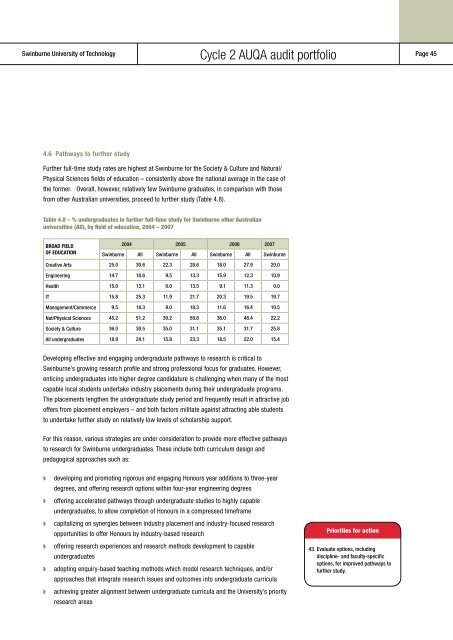pdf - Swinburne University of Technology
pdf - Swinburne University of Technology
pdf - Swinburne University of Technology
You also want an ePaper? Increase the reach of your titles
YUMPU automatically turns print PDFs into web optimized ePapers that Google loves.
<strong>Swinburne</strong> <strong>University</strong> <strong>of</strong> <strong>Technology</strong> Cycle 2 AUQA audit portfolio Page 45<br />
4.6 Pathways to further study<br />
Further full-time study rates are highest at <strong>Swinburne</strong> for the Society & Culture and Natural/<br />
Physical Sciences fields <strong>of</strong> education – consistently above the national average in the case <strong>of</strong><br />
the former. Overall, however, relatively few <strong>Swinburne</strong> graduates, in comparison with those<br />
from other Australian universities, proceed to further study (Table 4.8).<br />
Table 4.8 – % undergraduates in further full-time study for <strong>Swinburne</strong> other Australian<br />
universities (All), by field <strong>of</strong> education, 2004 – 2007<br />
brOAd fIeLd<br />
Of edUCATIOn<br />
2004 2005 2006 2007<br />
<strong>Swinburne</strong> All <strong>Swinburne</strong> All <strong>Swinburne</strong> All <strong>Swinburne</strong><br />
Creative Arts 25.0 30.6 22.3 28.6 18.0 27.9 20.0<br />
Engineering 14.7 18.6 9.5 13.3 15.9 12.3 10.9<br />
Health 15.0 13.1 0.0 13.5 9.1 11.3 0.0<br />
IT 15.8 25.3 11.9 21.7 20.3 19.5 19.7<br />
Management/Commerce 9.5 18.3 9.0 18.3 11.6 16.4 10.5<br />
Nat/Physical Sciences 45.2 51.2 30.2 50.8 36.0 48.4 22.2<br />
Society & Culture 36.0 30.5 35.0 31.1 35.1 31.7 25.8<br />
All undergraduates 18.9 24.1 15.8 23.3 18.5 22.0 15.4<br />
Developing effective and engaging undergraduate pathways to research is critical to<br />
<strong>Swinburne</strong>’s growing research pr<strong>of</strong>ile and strong pr<strong>of</strong>essional focus for graduates. However,<br />
enticing undergraduates into higher degree candidature is challenging when many <strong>of</strong> the most<br />
capable local students undertake industry placements during their undergraduate programs.<br />
The placements lengthen the undergraduate study period and frequently result in attractive job<br />
<strong>of</strong>fers from placement employers – and both factors militate against attracting able students<br />
to undertake further study on relatively low levels <strong>of</strong> scholarship support.<br />
For this reason, various strategies are under consideration to provide more effective pathways<br />
to research for <strong>Swinburne</strong> undergraduates. These include both curriculum design and<br />
pedagogical approaches such as:<br />
w developing and promoting rigorous and engaging Honours year additions to three-year<br />
degrees, and <strong>of</strong>fering research options within four-year engineering degrees<br />
w <strong>of</strong>fering accelerated pathways through undergraduate studies to highly capable<br />
undergraduates, to allow completion <strong>of</strong> Honours in a compressed timeframe<br />
w capitalizing on synergies between industry placement and industry-focused research<br />
opportunities to <strong>of</strong>fer Honours by industry-based research<br />
w <strong>of</strong>fering research experiences and research methods development to capable<br />
undergraduates<br />
w adopting enquiry-based teaching methods which model research techniques, and/or<br />
approaches that integrate research issues and outcomes into undergraduate curricula<br />
w achieving greater alignment between undergraduate curricula and the <strong>University</strong>’s priority<br />
research areas<br />
Priorities for action<br />
43. Evaluate options, including<br />
discipline- and faculty-specific<br />
options, for improved pathways to<br />
further study.

















